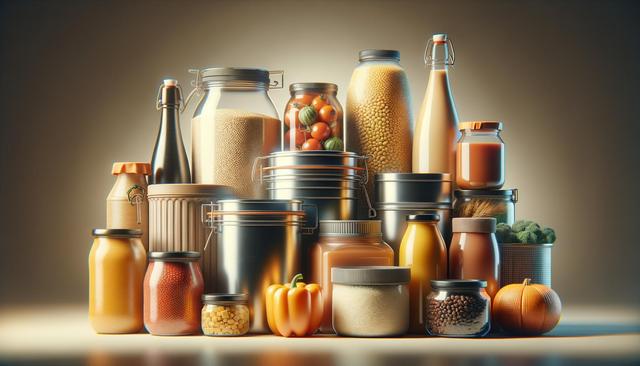Why Food Storage Containers Matter
Food storage containers play a crucial role in maintaining an efficient and hygienic kitchen. From preserving leftovers to organizing pantry essentials, the right container can make a significant difference in reducing food waste and improving accessibility. Whether you’re prepping meals for the week or storing dry ingredients, having a reliable set of containers helps extend the shelf life of your food and keeps your kitchen clutter-free.
Proper food storage also contributes to food safety. Airtight lids prevent contamination and exposure to moisture, pests, or odors. This is especially beneficial for items like grains, flour, and spices. Moreover, transparent containers help you identify contents quickly, reducing the need to open and reseal frequently. This not only saves time but also helps maintain freshness.
Investing in a variety of sizes allows for greater flexibility. Small containers are ideal for sauces and dressings, while larger ones accommodate bulk items like pasta or rice. A well-thought-out system of storage can lead to better meal planning and less last-minute waste.
Types of Food Storage Containers
There are several types of food storage containers available, each with its unique benefits. The materials and design you choose will depend on your specific needs, such as storing cooked meals, raw ingredients, or snacks.
Common materials include:
- Plastic: Lightweight and often stackable, plastic containers are a convenient choice for everyday use. Look for BPA-free options to ensure food safety.
- Glass: Durable and microwave-safe, glass containers are excellent for reheating and long-term storage.
- Silicone: Flexible and space-saving, silicone containers are great for freezer storage and transporting meals.
Some containers are designed specifically for certain tasks, such as vacuum-sealed containers for extended freshness or compartmentalized boxes for meal prepping. Choosing the appropriate type can improve both the efficiency and safety of your food storage practices.
Organizing Your Pantry and Refrigerator
Using food storage containers effectively can transform your pantry and refrigerator into well-ordered spaces. By decanting items like cereals, grains, and baking supplies into labeled containers, you make it easier to keep track of inventory and reduce visual clutter.
Here are some practical organization tips:
- Group similar items together, such as snacks, baking ingredients, or canned goods.
- Label containers clearly with contents and expiration dates.
- Use stackable containers to maximize vertical space.
- Rotate older items to the front to ensure they are used first.
In the refrigerator, containers can help separate different food groups and prevent cross-contamination. For instance, storing fruits and vegetables in dedicated bins keeps moisture levels balanced and reduces spoilage. Transparent bins also make it easier to spot ingredients at a glance, reducing overbuying or forgetting what you already have.
Eco-Friendly and Reusable Options
More people are turning to sustainable food storage solutions as awareness of environmental issues grows. Reusable containers not only cut down on single-use plastics but also save money in the long run. Durable containers can be used repeatedly for years, minimizing the need for disposable packaging.
Eco-conscious options include:
- Beeswax wraps for covering bowls or wrapping produce.
- Glass jars for storing dry goods or leftovers.
- Silicone bags as an alternative to plastic sandwich bags.
By choosing materials that are easy to clean and long-lasting, you can reduce your ecological footprint without sacrificing functionality. Additionally, many reusable containers are compatible with dishwashers and microwaves, making them convenient for daily use.
Reducing reliance on disposable items can also inspire more mindful consumption habits. When you invest in quality containers, you’re more likely to plan meals, store leftovers efficiently, and avoid unnecessary waste.
Maintaining and Cleaning Containers
To ensure longevity and hygiene, food storage containers must be cleaned and maintained properly. While many are dishwasher-safe, some materials require gentle handwashing to prevent warping or damage over time.
Here are a few maintenance tips:
- Avoid using abrasive sponges on plastic or silicone surfaces.
- Dry containers completely before storing to prevent mold or mildew.
- Remove stains or odors using natural solutions like baking soda and vinegar.
- Inspect lids and seals regularly to ensure they remain airtight.
Proper care not only extends the life of your containers but also ensures they remain safe for food storage. Over time, damaged or warped containers can harbor bacteria or compromise food quality, so it’s important to replace them when necessary.
Storing lids and bases together or using lid organizers can help keep your kitchen tidy and reduce the time spent searching for matches. An organized storage system encourages continued use and supports efficient kitchen routines.
Conclusion: Make the Most of Your Kitchen Storage
Food storage containers are a practical addition to any kitchen, offering benefits that extend beyond simple organization. By choosing a mix of materials and sizes, maintaining them well, and using them thoughtfully, you can enjoy a cleaner, more efficient cooking space. Whether your goal is reducing food waste, saving time on meal prep, or supporting a more sustainable lifestyle, the right containers can support your efforts effectively. Thoughtful storage decisions can lead to better habits, fresher ingredients, and a more enjoyable kitchen experience overall.


